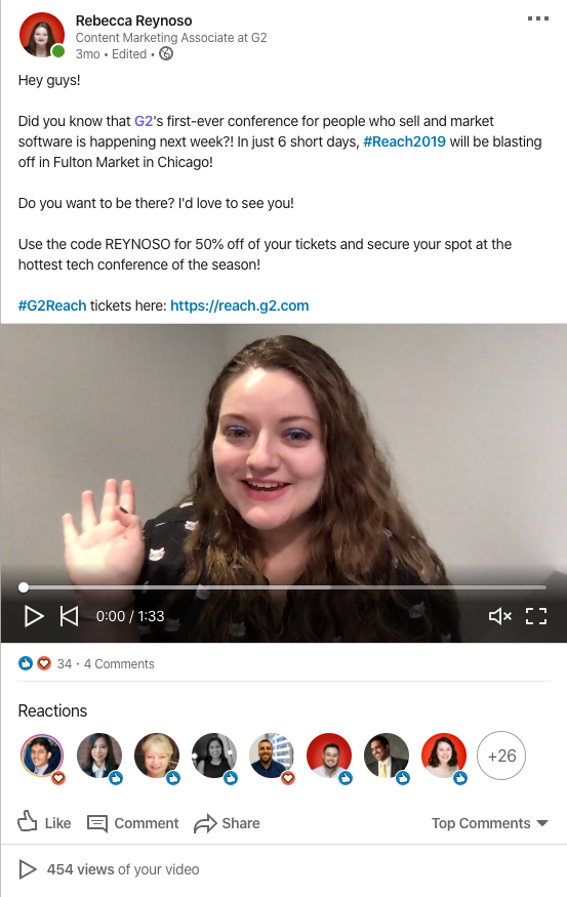3 Content Marketing Tips for Event Professionals

To promote an event successfully, you’ll need to create the right kind of buzz. And one of the easiest ways of doing this is using content that engages audiences – right from the start. In fact, not making the most out of the content you can create around your events may mean missing out on a huge opportunity for brand promotion and highlighting what makes your event a “can’t-miss” experience.
We spoke to Rebecca Reynoso, content editor at leading software reviews site, G2, to find out what kind of content works best for event marketing and how that content can be leveraged to engage audiences before, during and after an event.
How to Create Content Around Your Event
Before your event can go off without a hitch, you’ll need to make sure people know about it, are excited for it, and most importantly – are spreading the word about it. Word-of-mouth marketing is one of the core ways to get your event “seen” by the larger audience you’re targeting as the market for your event. In order for this to happen though, you’ll need to create content about your event before it occurs, while it’s happening and after it’s over.
You can’t sloppily put just anything out into the world. You have to create the right types of content in order to ensure your event stands out against the competition. Project management tools can keep you organised during the creation process and ensure that you’re covering your bases. The following types of content are not only the easiest to produce, but will be expected by your customers, clients, and extended audience following the progression of your event from start to end.
1. Write Blog Posts
As with any company that is hosting an event, it’s crucial to have literature that can be disseminated easily. Blog posts are the simplest way to get the word out quickly and create high-quality content for your readers. Before the event, you can write articles that discuss the purpose of your event and highlight the core details readers want to know: Date, time, location, length, and event type.
Give pre-event information
As mentioned above, all the nitty-gritty details will be the deciding factor for many on-the-fence attendees. Remember that not all of your potential attendees live down the block; some may be coming from overseas. So knowing the basics like when and where the event will be should be your priority.
Secondary information such as which speakers will be there, the topics they’ll be covering, and the overall schedule of events should be the next most important information to release to the public.
All of this information can be written in a single or series of blog posts – whichever makes more sense for your brand. Plus, once you have a blog post published, you can share it on your social platforms as many times as you’d like up until the event, including day-of.
Provide readers with a FAQ section
Besides the where, when, and what, people will also want information on things like the venue, food and drink options, accessibility, and more. Is there onsite parking, and if so, is it free? How can I access the event via public transit? When the event is over, are there any good restaurants around to have a sit-down meal or have meetings?
Queries like these and many more will arise, so answer them before you get bombarded with emails about event-adjacent concerns. Not only does this put your attendees’ minds at ease, it shows that you know what you’re talking about, which tells people – chill, we’ve got this!
Get attendees “in the know” about speakers and their presentations
Nobody likes going into an event blind. Which means it is your responsibility to craft content about your event speakers, the topics they’ll be covering, and some background information so people who don’t know a speaker by name can get to know them before the day of the event.
Some easy-to-create content would be a “5 fast facts about [speaker name]” where you list what the speaker does, why they were chosen, and what value they’ll be providing to attendees. Show people your event is valuable and make them feel that missing it will leave them with FOMO (fear of missing out) syndrome.
Read: How to Create Invites that Draw People to Your Events
2. Be Active on Social Media
You should always maintain an active social media presence – before, during and after an event. Where flyers and handouts might have been the main information source years ago, the past decade has proven time and again that social media is the quickest way to spread the word. It’s a great way to share information or even implement a social media contest to gain followers and increase awareness around your event.
Read: Top Social Media Trends for Event Marketers
It’s no secret we live in an era where if you as a brand or company are not active on social media, people tend to wonder why. If your competition is on the ‘gram and you’re nowhere to be found, chances are they’re reaching a wider audience than you could ever hope to.
With this in mind, it’s crucial to show a strong presence on social media at all times, but most especially over the course of your event. Below are three of the most crucial social media platforms to use if you want to engage a highly-social audience: Twitter, LinkedIn, and Instagram.
Live tweet during the event (and beforehand)
Assuming your company is active on Twitter, the main account should be tweeting reminders semi-regularly to keep interested parties up-to-date about any coming changes. Did a speaker who was scheduled bow out? Let your followers know.
In fact, dedicating a few members of your social media squad or general marketing team to do the legwork of live tweeting during the actual event can take some of the stress off for the event organiser. Better yet, you can set posts to go out at specific times, e.g. when one of your speakers is scheduled, have your social media management software automatically tweet an image of the speaker with a quote from their latest novel to prep your social network for what’s to come.
Whatever you choose, make sure your company’s Twitter account is tweeting often. Something as simple as speaker insights or quick and memorable quotes that have the #EventHashtag of your choice can bring massive exposure to the event as it’s ongoing.
Make LinkedIn statuses and videos to promote your event
To promote an event, many companies will use their LinkedIn page, and that of their employees who are involved with the event planning process, to promote the event itself. Whether that’s by sharing a new LinkedIn status as a reminder to connections or crafting a 2-minute video that’s sure to capture the attention of even casual followers. The more you post, the more attention you’re bound to receive.
For instance, in the video below, I helped my company promote our first-ever event, #G2Reach, with a simple video reminding my connections of the looming event date – and a sweet 50% off code for their ticket purchase. That was guaranteed to spark interest among people who were on the fence.

The success is in the numbers. Over 450 people viewed the video and 34 people reacted to it. Every time someone reacts to a post on LinkedIn, their connections get a notification as well. Basically, you make a short, informative video and your connections will create word of mouth promotion for you. It’s a win-win, really. And whether the views and likes amounted to direct ticket sales or not, the fact of the matter is the video drummed up talk about the event, which was its intended purpose.
Read: Why Video is a Big Deal for Marketing Your Events
Post on Instagram Stories in the days leading up to your event
There’s probably a whole discourse around whether Snapchat or Instagram is the hotter app to have (even with TikTok creeping its way to the top), but Instagram’s Stories feature is a must-use for event promotion with 2020 on the horizon.
Weeks before the event, have your company’s VP of Marketing (or a similar high-level figure) make an Instagram Story video about how pumped they are for the coming event. They can let your Insta followers know what to expect in much shorter, more conversational form than a formal blog post.
A 30-second video clip of the VP outside of the venue a few days beforehand showing the set-up process is a fun, no-frills way to let people know that everything’s going smoothly, which should get them excited to be attending your exclusive event. You can even set up polls so your viewers engage with your Instagram Stories.
And on the day of your event, share user Instagram photos and Stories to the main company Instagram page. Whenever you’re tagged in something, it becomes accessible for you to share on your own page, so take advantage of this feature. A small action like this makes attendees feel “seen” and important.
3. Follow-Up with Attendees Post-Event
Not only should you be sending out thank-you emails to everyone who purchased a ticket to attend your event, but you should provide them with a takeaway in the form of exclusive, attendee-only content that is gated for non-attendees, but free and accessible for those who were there. Prioritise high-quality content and ensure that your emails are deliverable so your audience can enjoy your event even after it’s over. You can also make things easier by using an event management software that can automatically pre-schedule all the emails you want to send to people engaging with your events.
Whether it’s exclusive photos, videos of all of the speaker presentations, a downloadable mini eBook with insights about the event, or something else, giving special treatment in terms of exclusive content is one way to win over attendees and get them excited for next year’s event!
Taking Over the World One Event at a time
Now that you have a fully-loaded toolbox to help you craft content for your event, you might be wondering how to take your event content to the next level. The key is integrating a mobile-friendly element to your events via a mobile event app platform.
Not only do your attendees get to access all of your content from their computers, but they can access and share all content surrounding your event straight from their phones. Overall, it’s something no event should be without!
Would you like similar articles delivered to your inbox? Why not sign up to our weekly EventTech Talk newsletter for tips, analysis and research reports on all the latest technology and marketing trends shaping the events industry today.
